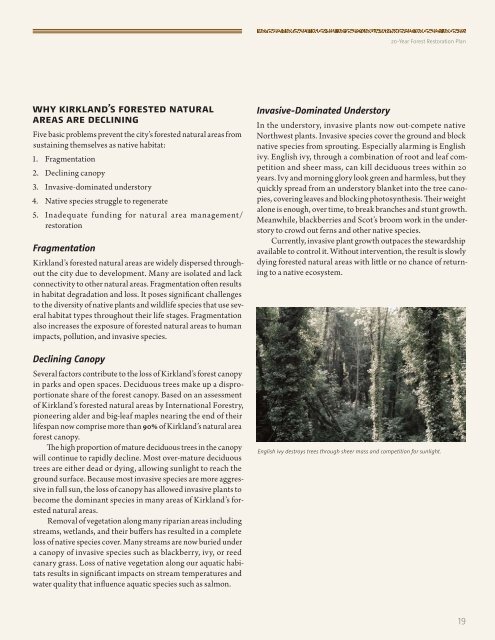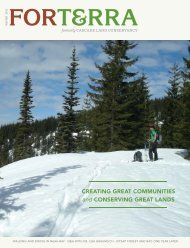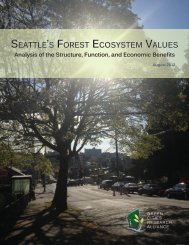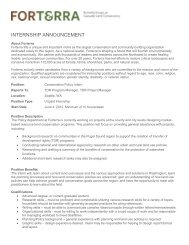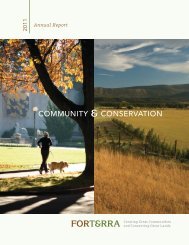20-year Forest Restoration Plan - City of Kirkland
20-year Forest Restoration Plan - City of Kirkland
20-year Forest Restoration Plan - City of Kirkland
- No tags were found...
Create successful ePaper yourself
Turn your PDF publications into a flip-book with our unique Google optimized e-Paper software.
<strong>20</strong>-Year <strong>Forest</strong> <strong>Restoration</strong> <strong>Plan</strong>Why <strong>Kirkland</strong>’s <strong>Forest</strong>ed NaturalAreas are DecliningFive basic problems prevent the city’s forested natural areas fromsustaining themselves as native habitat:1.2.3.4.5.FragmentationDeclining canopyInvasive-dominated understoryNative species struggle to regenerateInadequate funding for natural area management/restorationFragmentation<strong>Kirkland</strong>’s forested natural areas are widely dispersed throughoutthe city due to development. Many are isolated and lackconnectivity to other natural areas. Fragmentation <strong>of</strong>ten resultsin habitat degradation and loss. It poses significant challengesto the diversity <strong>of</strong> native plants and wildlife species that use severalhabitat types throughout their life stages. Fragmentationalso increases the exposure <strong>of</strong> forested natural areas to humanimpacts, pollution, and invasive species.Declining CanopySeveral factors contribute to the loss <strong>of</strong> <strong>Kirkland</strong>’s forest canopyin parks and open spaces. Deciduous trees make up a disproportionateshare <strong>of</strong> the forest canopy. Based on an assessment<strong>of</strong> <strong>Kirkland</strong>’s forested natural areas by International <strong>Forest</strong>ry,pioneering alder and big-leaf maples nearing the end <strong>of</strong> theirlifespan now comprise more than 90% <strong>of</strong> <strong>Kirkland</strong>’s natural areaforest canopy.The high proportion <strong>of</strong> mature deciduous trees in the canopywill continue to rapidly decline. Most over-mature deciduoustrees are either dead or dying, allowing sunlight to reach theground surface. Because most invasive species are more aggressivein full sun, the loss <strong>of</strong> canopy has allowed invasive plants tobecome the dominant species in many areas <strong>of</strong> <strong>Kirkland</strong>’s forestednatural areas.Removal <strong>of</strong> vegetation along many riparian areas includingstreams, wetlands, and their buffers has resulted in a completeloss <strong>of</strong> native species cover. Many streams are now buried undera canopy <strong>of</strong> invasive species such as blackberry, ivy, or reedcanary grass. Loss <strong>of</strong> native vegetation along our aquatic habitatsresults in significant impacts on stream temperatures andwater quality that influence aquatic species such as salmon.Invasive-Dominated UnderstoryIn the understory, invasive plants now out-compete nativeNorthwest plants. Invasive species cover the ground and blocknative species from sprouting. Especially alarming is Englishivy. English ivy, through a combination <strong>of</strong> root and leaf competitionand sheer mass, can kill deciduous trees within <strong>20</strong><strong>year</strong>s. Ivy and morning glory look green and harmless, but theyquickly spread from an understory blanket into the tree canopies,covering leaves and blocking photosynthesis. Their weightalone is enough, over time, to break branches and stunt growth.Meanwhile, blackberries and Scot’s broom work in the understoryto crowd out ferns and other native species.Currently, invasive plant growth outpaces the stewardshipavailable to control it. Without intervention, the result is slowlydying forested natural areas with little or no chance <strong>of</strong> returningto a native ecosystem.English ivy destroys trees through sheer mass and competition for sunlight.19


